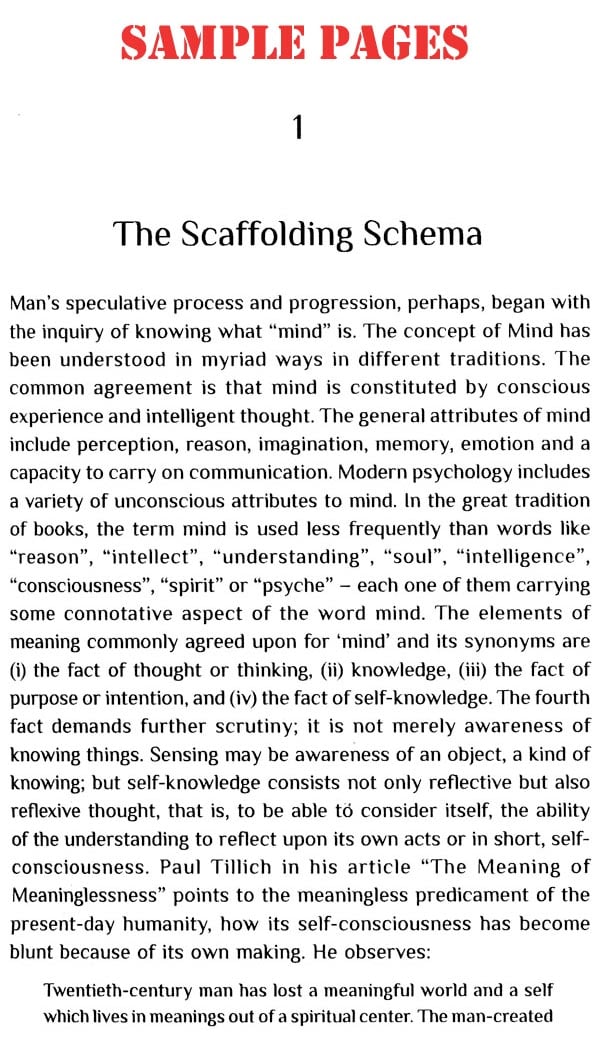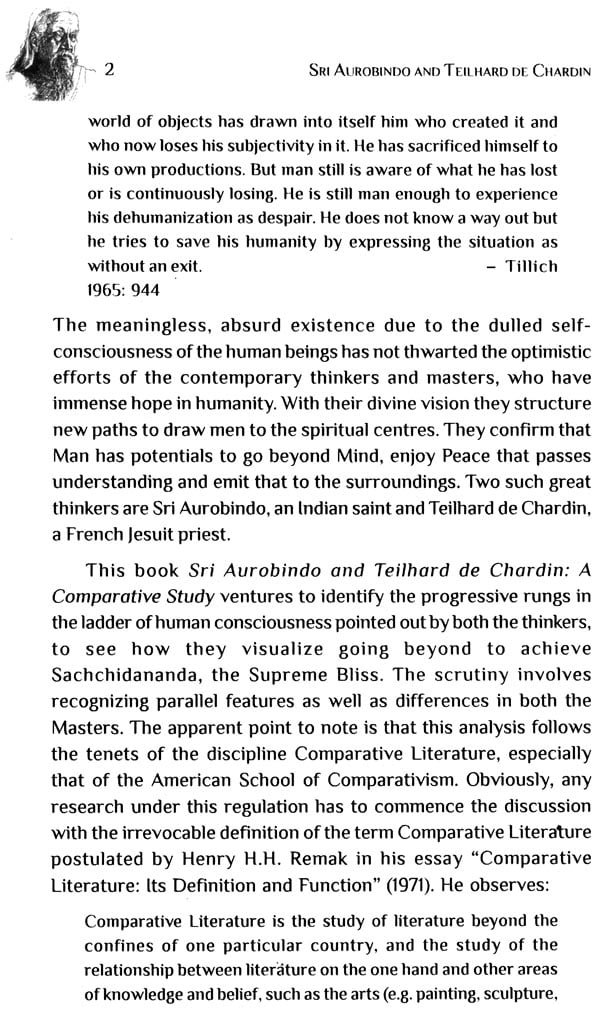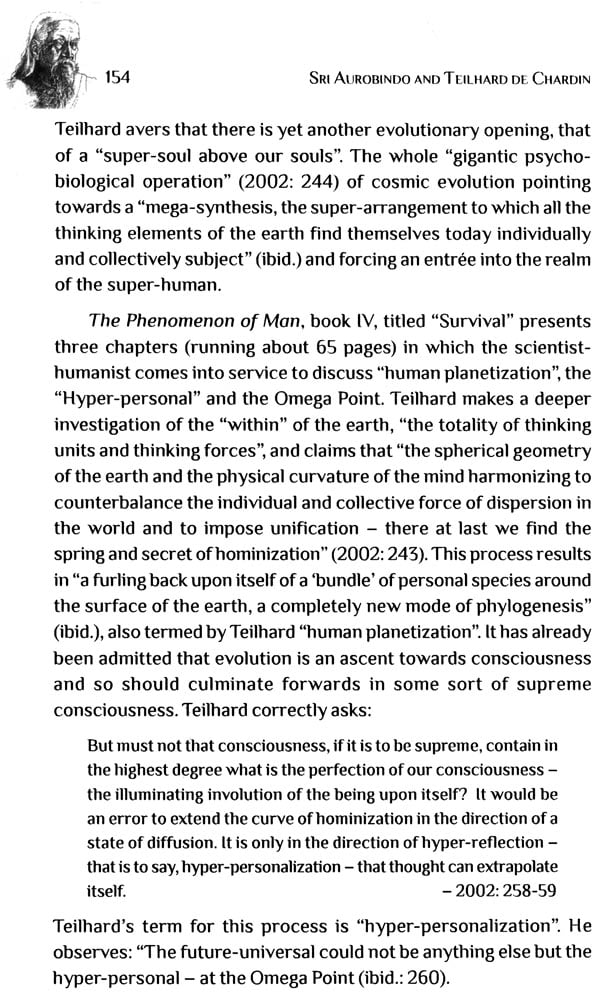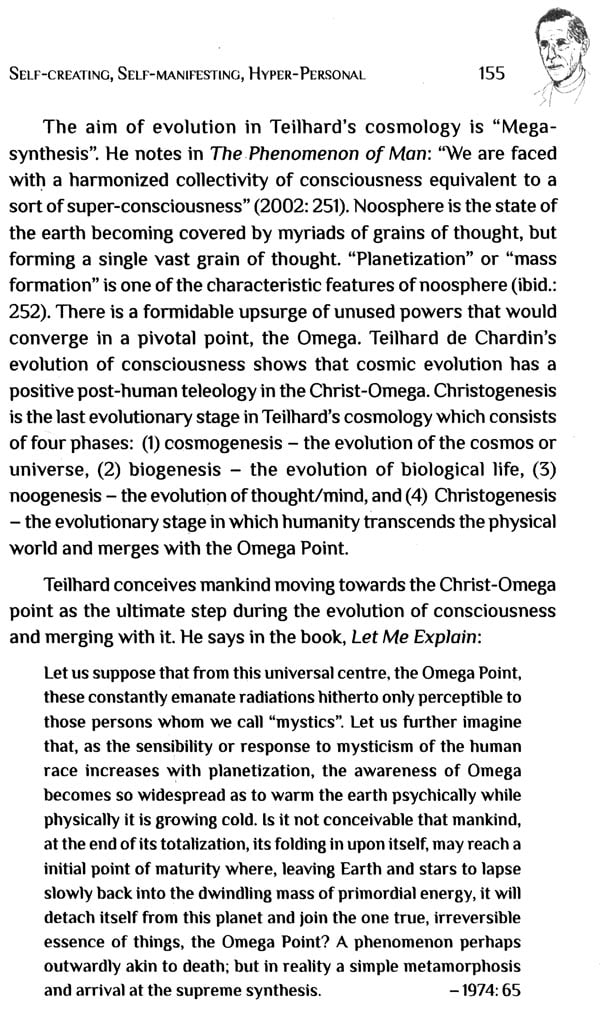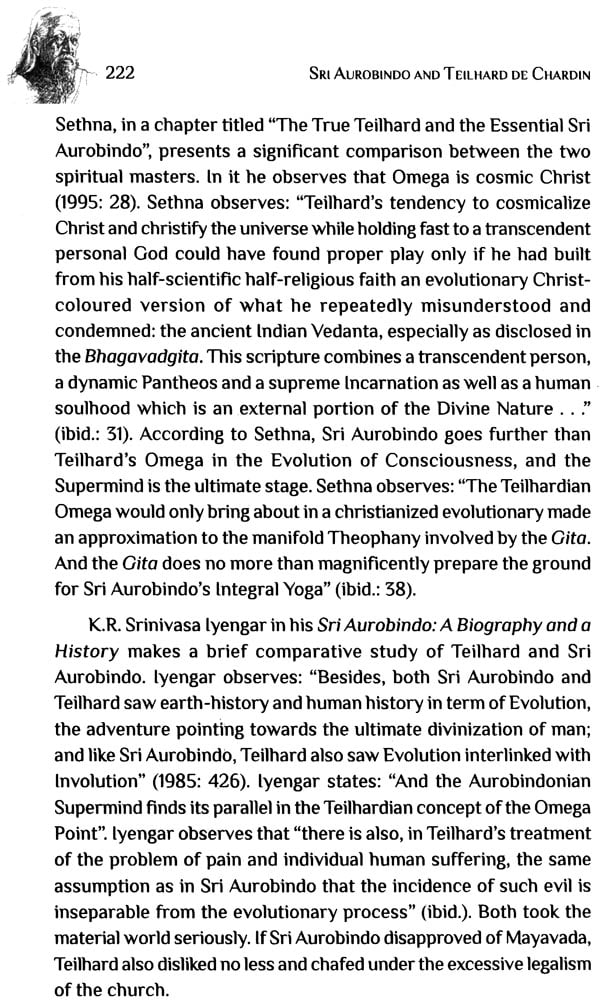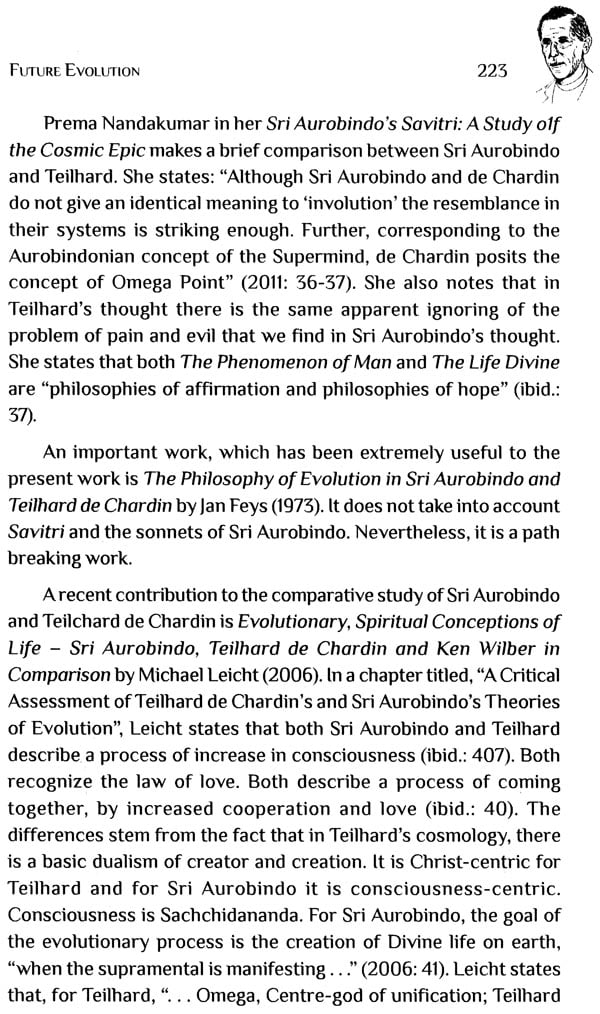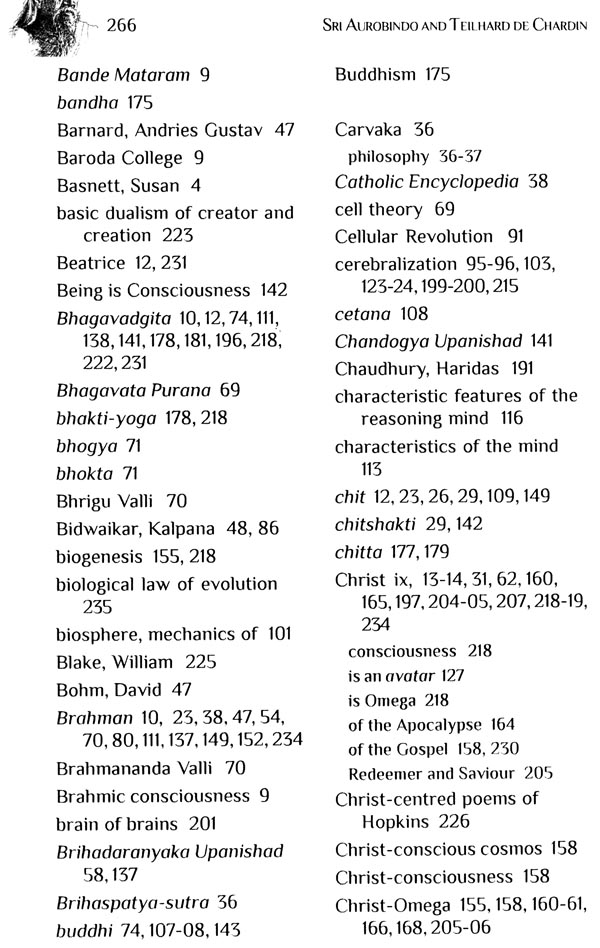
Sri Aurobindo and Teilhard De Chardin (A Comparative Study)
Book Specification
| Item Code: | NAO984 |
| Author: | R. Subramony |
| Publisher: | Academic Publishing International |
| Language: | English |
| Edition: | 2019 |
| ISBN: | 9788193815809 |
| Pages: | 295 |
| Cover: | HARDCOVER |
| Other Details | 9.00 X 6.00 inch |
| Weight | 700 gm |
Book Description
Sri Aurobindo and Teilhard de Chardin: A Comparative Study ventures into identify the progressive rungs in the ladder of human consciousness pointed out by both the thinkers, to see how they visualize going beyond to achieve Sachchidanda, the Supreme Bliss. The scrutiny involves recognizing parallel features as well as differences in both the philosophers.
Their writings are extremely significant in a phase where the future of humanity is at risk. Sri Aurobindo, who is steeped in the Vedic wisdom of the ancient India, calls up on us to shed our selfish nature and reach the higher levels of Consciousness. Teilhard de Chardin, a Jesuit priest, exhorts us to unite and shed divisions. There is a striking similarity in their cosmologies. Sri Aurobindo's concept of Supermind is the last stage in evolution and Teilhard's Omega Point is the summit of evolution. Their process of evolution contains a 'triple transformation' of consciousness. The book critically thus analyses many philosophical concerns of both Sri Aurobindo and de Chardin.
Dr R. Subramony (1976—), is Associate Professor and Head of the Department of English at The Madura College (Autonomous), Madurai, Tamil Nadu. He was born in Thiruvananthapuram in a family that hailed from Palakkad district of Kerala. A postgraduate in English literature, he was awarded PhD for his thesis on "Comparative Study of Sri Aurobindo and Teilhard de Chardin". His first book Frying Pan and Other Stories was published under the nom de plume Raja. He has to his credit another book Paramahamsa: A Vedantic Tale and several other books covering the field of Indian religion and philosophy.
The meaningless, absurd existence due to the dulled self-consciousness of the human beings has not thwarted the optimistic efforts of the contemporary great thinkers and masters, who have immense hope in humanity. With their divine vision they structure new paths to draw men to the spiritual centres. Two such great thinkers are Sri Aurobindo, an Indian saint and Pierre Teilhard de Chardin, a French Jesuit priest. This book Sri Aurobindo and Teilhard de Chardin ventures into identify the progressive rungs in the ladder of human consciousness pointed out by both the thinkers, to see how they visualize going beyond to achieve Sachchidananda, the Supreme Bliss. The scrutiny involves recognizing parallel features as well as differences in both the Masters. The apparent point to note is that this analysis follows the tenets of the discipline Comparative Literature, especially that of the American School of Comparativism.
Humanity is divided on various lines. The future of mankind is under threat. In this context the writings of these two seers, Sri Aurobindo and Teilhard de Chardin are extremely significant. They offer as a positive message to the fractured world. Sri Aurobindo is steeped in the Vedic and Upanishadic traditions of ancient India. His writings not only remind us of the role of India as the spiritual guru of the world but also inspire us to get rid of our selfish nature, and reach higher levels of consciousness. Teilhard de Chardin has a similar message and, using the framework of the Christian religion, exhorts mankind to unite and shed divisions. He envisages the extermination of national and regional differences, thereby the prospects of human race becoming one. Sri Aurobindo envisions the arrival of a supramental race, and the gradual supramentalisation of mankind. There is a striking parallel in the respective cosmologies of Sri Aurobindo and Teilhard de Chardin. The endeavour of this research is to highlight the convergences and divergences in the theory of evolution of these two masters. The relevance of these two writers in our times has also been stressed on.
Comparative Literature is the study of literature beyond the confines of one particular country, and the study of the relationship between literature on the one hand and other areas of knowledge and belief, such as the arts (e.g. painting, sculpture, architecture, music), philosophy, history, and social science (e.g. politics, economics, sociology), religion, etc. on the other. In brief, it is the comparison of one literature with another and the comparison of literature with other spheres of human experience. The Comparative Literature scholars attempt to integrate literary experience with other cultural phenomena such as historical change, philosophical concepts and social movements. The recent trends in Comparative Literature also reflect the growing importance of cultural studies in the fields of literature, as the comparatists avidly focus on a cross-cultural approach. Works of this nature include Gayatri Chakravorty Spivak's Death of a Discipline and David Damrosch's What Is World Literature? Steven Totosy de Zepetnek proposes a new programme of study, with a theoretical approach, Comparative Cultural Studies, that would disrupt the established hierarchy of cultural products and would pluralize and parallelize the study of culture without hierarchization. The parallel study between the select works of Sri Aurobindo and Teilhard de Chardin — in the lines discussed above — is an interface study based on systems approach, wherein the rewritings of Teilhard — his works in French have been translated into English — and his system are taken into account to study how they concur with the system explicated in Sri Aurobindo's works, chiefly his prose magnum opus, The Life Divine. The methodology also pertains to "cultural relativism", earnestly discussed by Andre Lefevere as "resocialization of literature".
Sri Aurobindo's philosophical masterpiece is The Life Divine, his spiritual manifesto wherein he describes the process of involution and evolution of the Sachchidananda which descends into various stages of mind, life, matter and finally into inconscience. Then evolution happens in matter, life, mind, Supermind and finally to attain Sachchidananda. Savitri: A Legend and a Symbol, his yet another masterpiece, is also taken for study. His cosmological framework is based on the tenets of the Vedas and Upanishads. Teilhard de Chard in, also a paleontologist, considered as one of the greatest minds of the twentieth century, formulated a synthesis of the theories of evolution in a different way with the Christian world view. He has a universal, integrated vision. Teilhard the visionary spent his entire life trying to integrate religious experience with natural science, most specifically the Christian theology with theories of evolution. In this effort he foresees the possibilities of humankind as heading for an exciting convergence of systems, an Omega Point, where there would be an integration of consciousness. For Teilhard the Omega was the cosmic apex, the Christ, the Spirit of the Earth. This will lead man to a new state of peace and planetary unity, based intrinsically upon the spirit of the Earth. His masterpiece is The Phenomenon of Man.
Sri Aurobindo's evolutionary cycle begins with the inconscient and thereafter the first three stages are matter, Life and mind. There is an involution of the spirit into matter. For Sri Aurobindo, matter evolves. Teilhard has high regard for lithosphere" or matter. His prose-poem "Hymn to Matter" reveals his respect for matter. In The Phenomenon of Man, Teilhard states that matter has three aspects — plurality, unity and energy. He has also described the System, the Totem and the Numerical Laws of Matter. The evolution is a two-way process, both for Sri Aurobindo and Teilhard — there is involution and evolution. For both, matter is divine.
"Life" or vital in life-nature is made of feelings and passions. Sri Aurobindo poetically describes in Savitri that the desires of vital are possession of an object, money, power and fame. Teilhard de Chardin in the chapter on "Life", in The Phenomenon of Man describes the internal power of expansion and division that characterizes living material or the Biosphere. The mind works on the principle of division and brings in ignorance, separation, conflict of truths and loss of dynamic power. Sri Aurobindo meticulously describes the various stages in the evolution of the mind. The first is the Higher Mind, the next is the Illumined Mind followed by the Intuitive Mind. Above Intuitive Mind is the Overmind. In the cosmology of Teilhard, Noosphere is the thinking state. With the arrival of man, consciousness becomes self-conscious. Man has the ability to gear up to consciousness. In scientific terms, orthogenesis creates the cell, psychogenesis generates life and noogenesis intuits and inspires the mind. Noosphere is the world of the mind. The ego stands in the way of spiritual development. Teilhard stresses on the power of reflection in man. With the arrival of man, a new type of heredity, that of education has emerged, which has widened the horizons of knowledge. The new technology has created a new social order and a unified world state. But, the present state of the evolution of consciousness in man is not the end. To advance into Supermind is mandatory.
Sri Aurobindo states that we have to connect ourselves with our psychic being in order to evolve into the Supermind. Teilhard uses the word "love" in a mystical sense, in the place of the psychic being. For him, love is the most universal, the most tremendous and most mysterious of the cosmic forces. The last stage of evolution is Supermind in Sri Aurobindo's cosmology. It is Omega Point in Teilhard's cosmology. It is the summit of evolution. The process of evolution in Sri Aurobindo and Teilhard de Chardin also contains a "triple transformation" of consciousness. The three stages in Sri Aurobindo's cosmology are: (a) Psychic Transformation, (b) Spiritual Transformation, and (c) Supramental Transformation. In Teilhard it consists of: (1) a super-humanity, on the scale of the earth, (2) a super-Christ, on the scale of that super humanity, and (3) a super-charity on the scale both of the super-Christ and of super-humanity.
Both Sri Aurobindo and Teilhard have a common interest in the question of future evolution of man. For Teilhard, human evolution is a collective process of ascent, which culminates in oneness with God. At the Omega Point, union is achieved between man and God. But this convergence of humanity on 'Omega' results in its dissociation from the world. Sri Aurobindo would have the Superman realize the divine life on earth. Both Teilhard and Sri Aurobindo are concerned about the collective aspect of the future evolution of man and have predicted the divine destiny of man, in their numerous works. They have painstakingly tried to lead man to higher levels of consciousness. The confused youngsters of the present day are very much in need of such wisdom that strongly shows a coherent bond between science and religion. Science just cannot stop with its theories and hypotheses, just as religion cannot be grinding the same mill by dispersing the dry philosophies and insipid religious practices. A new awakening of thought and a fresh dissemination of knowledge are the need of the contemporary world. Scholars should rejuvenate themselves to haul out the ancient wisdom, to give new explication and to promote virtual globalization, that is, as per the saying of the yore, to establish vasudevah kutumpakam — the entire world is my home.
| PREFACE | vii | |
| Acknowledgements | xiii | |
| 1 | The Scaffolding Schema | 1 |
| 2 | The Matrix of Spirit — Matter and Lithosphere | 35 |
| 3 | Constructive Ingenuity of Energy — Life and Biosphere | 67 |
| 4 | Hominization : All Are Different, All Is One —Mind and Noosphere | 103 |
| 5 | Self-Creating, Self-Manifesting, Hyper-Personal — Supermind and Omega Point | 135 |
| 6 | The Divine in Collective Humanity: Triple Transformation | 173 |
| 7 | Future Evolution : Individual Core, Collectivism | 211 |
| 8 | Appendix : Glossary of Names and Terms | 237 |
| Bibliography | 251 | |
| Index | 265 |
